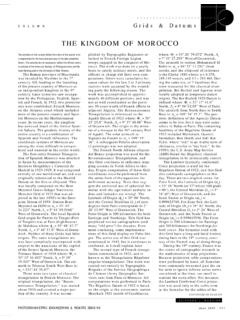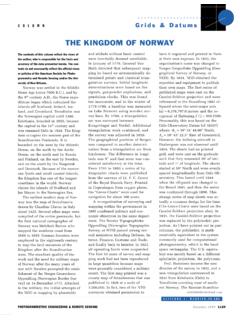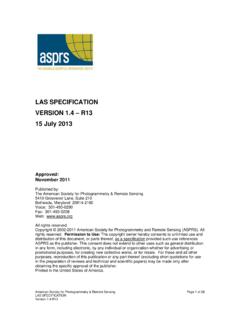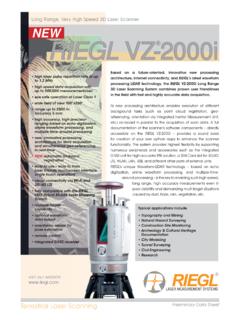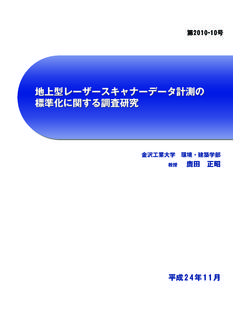Transcription of R&D OF MOBILE LIDAR MAPPING AND FUTURE TRENDS …
1 R&D OF MOBILE LIDAR MAPPING AND FUTURE TRENDS . Charles K. Toth, Senior Research Scientist The Ohio State University 470 Hitchcock Hall, 2070 Neil Ave, Columbus, OH 43212. ABSTRACT. MOBILE terrestrial MAPPING systems have seen remarkable developments recently. Fueled by an unprecedentedly strong demand for high-resolution and accurate 3D geospatial data, these systems serve the probably fastest growing market segment: city modeling. In particular, the recent introduction of powerful MOBILE laserscanning systems is of main interest, as the direct acquisition of 3D data greatly simplifies downstream processing, where until now stereo- based extraction was the most widely used feature extraction tool, requiring significantly more complex processing compared to the straightforward processing of explicit LIDAR data.
2 This paper reviews the recent developments in MOBILE MAPPING Technologies with a special focus on the MOBILE laserscanner sensor component. INTRODUCTION. MOBILE MAPPING Systems (MMS) were introduced in the early 90's, when, for the first time, the fledgling GPS. system was able to provide absolute positioning of MOBILE sensor platforms (Novak, 1993). Besides satellite-based navigation, imaging technology formed the second fundamental component of MMS, although at the beginning it was mainly limited to video-logging. The first research systems were simultaneously developed at the Center for MAPPING , The Ohio State University (Bossler and Toth, 1996), and the Department of Geomatics Engineering at The University of Calgary (El-Sheimy, 1996).
3 As technology continued to advance, both the georeferencing and imaging components improved significantly and commercial systems were introduced and became operational in the industrialized parts of world by the late 90's (Grejner-Brzezinska, 2001). During the last millennium, geospatial information science saw a major paradigm shift (Grejner-Brzezinska et al., 2004), triggered by the completion of the transition from analog to digital geospatial technologies. The debut of the first digital large-format aerial cameras in 2000 was the last needed development to achieve an entirely digital technology in airborne surveying (Petrie, 2003).
4 The totally digital workflow, including sensors, georeferencing, data acquisition, and processing, allowed for fundamentally different approaches. In addition, new sensors, such as laserscanners and interferometric RADAR (IfSAR) supported by enabling georeferencing technologies were introduced and started producing highly accurate data in large volume that was unprecedented. In a short time, MMS. became pervasive and ubiquitous. In fact, as the complexity of MMS systems increased, the name was slightly changed and now MOBILE MAPPING Technology (MMT) is widely used to reflect the stronger dependency on technology and the more sophisticated design, data processing and information extraction processes (Schwartz and El-Sheimy, 2007).
5 More recent developments include the introduction of Internet MAPPING , which has significantly increased the need for geospatial data worldwide. Initially, visualization, based on satellite and airborne imagery, was the main objective, but as the market started to develop, the need for 3D visualization started to grow, in particular, for major metropolitan areas. Demand for current airborne and terrestrial data has skyrocketed in a short time. In response, fleets of terrestrial MOBILE MAPPING vans with panoramic imaging capabilities were deployed in a short time. Similarly, airborne capacity to collect oblique and traditional vertical imagery has dramatically increased.
6 The most notable data provider of oblique imagery, Pictometry, Inc. operates a fleet of 70+ aircraft just in North America. The continuing trend is to move to full 3D city modeling, which means that besides imagery, terrain surface models and object descriptions are needed. While airborne LIDAR has been generally available, to accommodate this data need on the ground, MOBILE laser scanning is the feasible technology, which has seen phenomenal development in the last few years. The need for emergency MAPPING , such as to provide rapid MAPPING capabilities for man-induced and natural disasters, requires a fast response time, and thus, there is a growing need to improve real-time (or near real-time).
7 MMT capabilities. The totally digital workflow provides the basis but communication is also essential in most applications. An area where real-time operation is a must is autonomous vehicle navigation, which is still under intense research but expected to be operational in the next decade. ASPRS 2009 Annual Conference Baltimore, Maryland March 9-13, 2009. MOBILE MAPPING CONCEPT. The two fundamental components of MMT, GPS/INS-based direct georeferencing and digital imaging sensor(s), are usually modeled separately with further differentiating the laser and optical imaging sensors. Here a combined representation is provided for the sensor model that can be equally applied to laser and optical camera systems, including both frame and line camera (pushbroom) models.
8 Figure 1 shows the coordinate system definitions; note that the sensor frame is defined according to the conventional LIDAR notation, which is rotated180 around the X axis compared to the standard image sensor frame. Also, a polar coordinate system definition ( , ) is used to allow for a common treatment of the laser and image sensors. GPS antenna bGPS. pitch bINS C Sensor INS (t p ). yb yc b -frame s -frame roll xb yaw (t p ). zb xc rM ,INS (t p ). Ym Zm P. rM (t p , d S (t p )). m -frame Xm Figure 1. Coordinate system definitions. The mapped object point coordinates are computed according to the sensor equation: rM (t p , d S (t p )) = rM , INS (t p ) + RINS.
9 M. (t p ) ( RSINS RY ( (t p )) R X ( (t p )) d S (t p ) + bINS ). ASPRS 2009 Annual Conference Baltimore, Maryland March 9-13, 2009. where rM (tp) 3D coordinates of the sensed object point in the MAPPING frame 3D INS coordinates (origin) in the MAPPING frame, provided by GPS/INS (the rM , INS (tp) . navigation solution typically refers to the origin of the INS body frame). M. R INS (tp) Rotation matrix between the INS body and MAPPING frame RSINS Boresight matrix between the sensor frame and INS body frame Rotation matrix to describe the rotation of the sensing direction around the X. R XS , RYS . and Y axes of the sensor frame, respectively Sensing direction angle from the X axis of the sensor frame (xS is flight (tp).)
10 Direction, yS goes to the right, and zS goes down). (tp) Sensing direction angle from the Y axis of the sensor frame Range, either measured or unknown (distance from sensor reference point to d S (tp) . object point). Boresight offset vector (vector between laser sensor reference point and the bINS . origin of INS) defined in the INS body frame This formulation provides the first estimate for the geospatial positioning accuracy of a system, by defining an error boundary envelope. For LIDAR systems, all the parameters and measurements are known, so except for the effect of the footprint size and various object-space specific conditions, the accuracy estimates can be directly computed.


